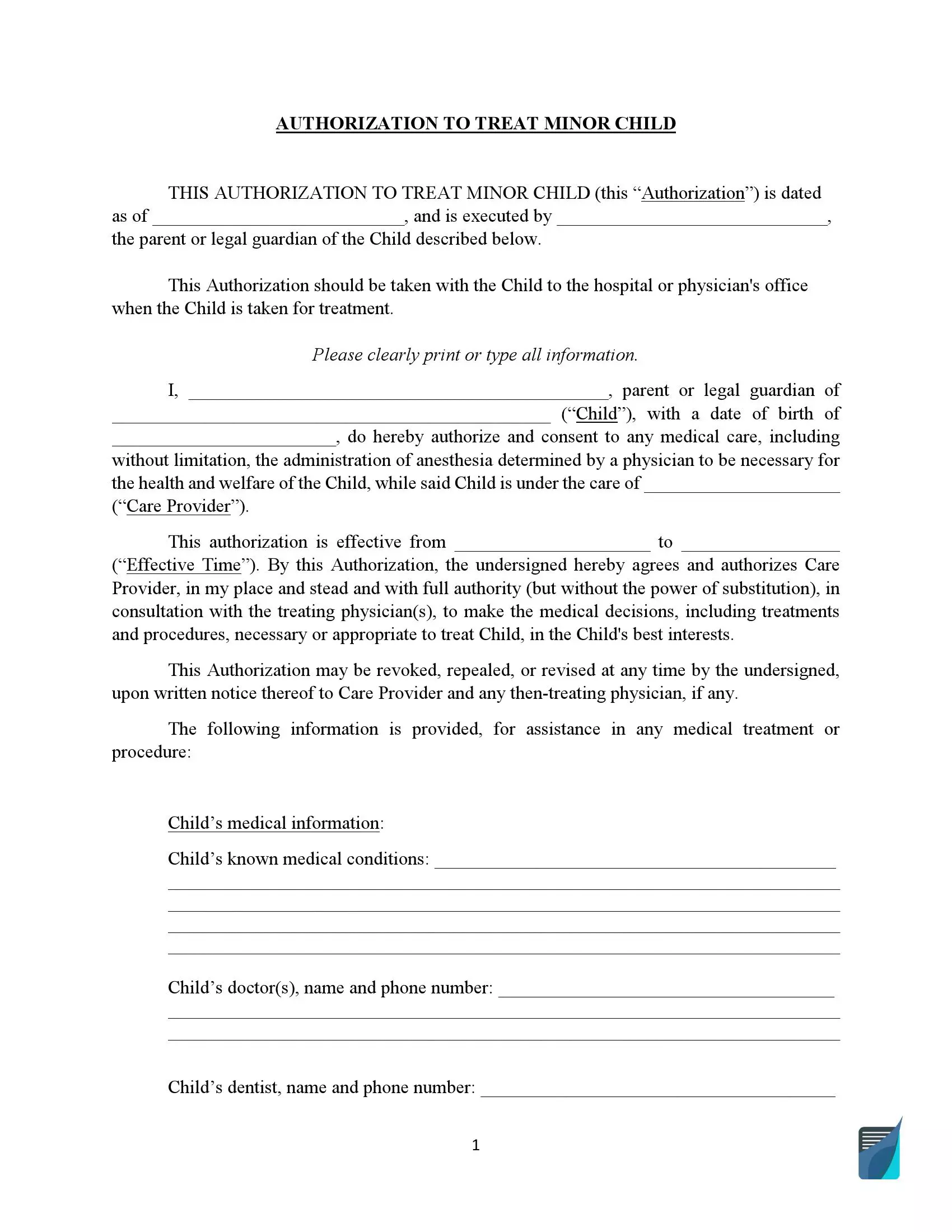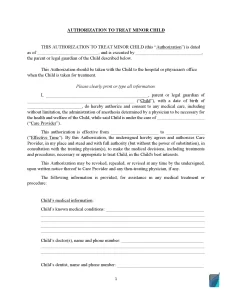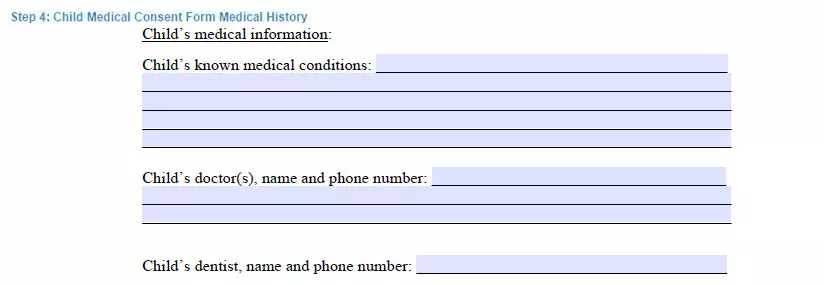Medical Consent Form for Minor
Most healthcare providers require consent to perform medical procedures or specific treatments, particularly for minors. In these cases, the parents or legal guardians consent to a child’s medical treatment.
However, if a child needs emergency medical treatment and a parent or guardian cannot be present at the hospital to give consent, a minor may not receive the necessary care in a timely manner. To overcome this challenge, you can use a treatment consent form, which transfers their authority to decide on health care treatment for the child when they are not nearby.

Build Your Document
Answer a few simple questions to make your document in minutes
Save and Print
Save progress and finish on any device, download and print anytime
Sign and Use
Your valid, lawyer-approved document is ready
What is a Minor Medical Consent Form?
A Minor Medical Consent Form is a legal document that grants a specified individual the temporary authority to act as a minor’s legal guardian in a medical setting and make decisions related to their healthcare.
This document empowers trusted individuals, such as a nurse, babysitter, teacher, coach, or grandparent, to provide medical consent for the child on behalf of a parent when they are not present.
You may encounter the following document name variants:
- Minor Medical Authorization Form
- Child Medical Release Form
- Caregiver Consent Form
Without a proper consent form in place, healthcare providers are often limited in their ability to administer medical care to minors. Medical consent forms for minors are essential for protecting children from unforeseen circumstances and ensuring their access to timely medical attention in the event of an emergency.
When to Use a Child Medical Consent Form
Under the law, healthcare providers require signed parental consent from a child’s parent or legal guardian before administering medical treatment to a minor. However, parents cannot always be present during emergencies, which is why they often appoint a designated person to represent their child’s interests in a medical setting.
A child medical consent form is primarily needed when children are under the supervision of adults other than their parents, who do not possess the legal authority to make medical decisions on their behalf.
Here are the most common situations where designating a caregiver to act in your child’s best interests is recommended:
- School trips, travels, or sports contests: Unexpected accidents can happen on the road or during vacations. Ensure that the person responsible for your child, such as a teacher or coach, can provide timely assistance to your child’s health while you are away. More: Field Trip Permission Form.
- Child in daycare or with a nanny: If your child spends most of their time in a childcare center or at home with a nanny, it is essential to authorize the responsible adult to make emergency decisions in case of an accident.
- Traveling or business trip-bound parents: Ensure that a reliable person, such as a grandparent, has the authority to decide on health-related matters for your child in your absence to avoid treatment delays.
- Divorced or separated parents: In some cases, parents agree on who has legal authority over medical decisions for their child. Having a child medical consent form ensures children receive medical treatment, regardless of whom they are staying with.
- Stepparents: Stepparents have limited rights concerning their stepchildren. They cannot authorize medical treatment, even for minor issues like a sprained leg or broken arm.
These situations typically involve healthy children, but if a child has chronic illnesses, allergies, or other medical issues, having a child medical consent form is essential.
How to Properly Give Child Medical Consent
To ensure the safety and well-being of your child, it is crucial to establish a temporary caretaker in a lawful manner. Here are some essential steps to follow when providing child medical consent, helping you minimize risks and guarantee that your child receives proper and timely medical treatment:
- Identify someone you can trust: Choose an adult who is in close proximity to your child and can be present in your absence. This could be a coach, teacher, nanny, or close friend.
- Inform the temporary guardian: If your child has specific medical conditions, allergies, or other health issues, the authorized person must be aware of these to react promptly and inform healthcare providers.
- Set an expiration date: Child medical consent forms grant temporary authority, so decide in advance how long the document will be valid.
- Sign and notarize: Such medical authorization cannot be agreed upon orally. To be legally valid, the document must be signed and notarized. This ensures that the consent form will be recognized by healthcare providers and institutions.
- Indicate the emergency contact person: Ensure the temporary guardian has your contact information and the contact details of your child’s primary care physician and other relevant healthcare providers.
- Specify the scope of consent: Clearly outline the extent of medical treatments and procedures the temporary guardian is authorized to consent to and any limitations or restrictions you would like to impose.

How to Fill Out the Child Medical Consent Template?
If you need a consent form for a minor, download the template from our website. To avoid any possible mistakes, follow this step-by-step guide on how to complete it correctly:
Step 1: Fill in the Authorization Date and Applicant’s Name
In the first part of the form, enter the date when the document is signed and the name of the applicant who authorizes the consent form—parent or legal guardian.

Step 2: Provide Child, Parent, and Medical Care Provider Details
The next part includes participants in the form—the Child, Parent, and Care Provider. The child medical consent form must be written in the name of the parent or legal guardian. In the same section, provide the child’s name and date of birth. Under Care Provider, enter the name of the entrusted person who will take care of your child in your absence.

Step 3: Specify the Effective Time
In the same section, indicate the period when the document will hold legal power. Mention both start and end dates.

Step 4: Include the Child’s Medical Information
The document must contain the child’s medical history. The child’s medical consent form should specify all the child’s medical records: known conditions, doctor’s contact information (phone number and name), prescribed medications, vaccination status, allergies, preferred medical facility, and any other pertinent information corresponding to the child’s health. Ensure you provide the most up-to-date and accurate data so that the child can receive proper treatment and medical attention if needed.

Step 5: Fill in the Insurance Information
The following section requires essential insurance information, including the insurance name, policy number, group number, phone number, and the insured’s name. Fill in all the fields with the correct information for the document to be authorized in medical institutions.

Step 6: Authorize and Sign the Form
Lastly, a parent or legal guardian must authorize the child medical consent form with their signature, date, and printed name.

FAQ
Is a child medical consent form enough for traveling?
When a child travels, it’s often necessary to have both a child medical consent form and a child travel consent form to ensure maximum protection from unforeseen events. It may be sufficient if the child travel consent includes a medical release section. However, if this section is absent, be sure to provide a caregiver with the authority to decide on healthcare treatment for the child when needed.
Will a child consent form allow my child to get medical treatment in a different state?
A child medical consent form is typically state-specific, meaning it will be authorized in most states if it complies with the issuing state’s laws. However, some states may require a parent or legal guardian to provide a power of attorney for a caregiver to have the right to address the child’s medical issues.
Does child medical consent make me give up my parental rights?
Absolutely not. The child medical consent form only grants a designated person temporary rights to make medical decisions on behalf of your child.
How do I terminate this medical treatment authorization form?
The end date of the document’s validity is usually indicated on the form. However, you have the right to revoke or repeal the document at any time. To do so, notify the temporary caregiver and medical personnel about the change in guardian status.
What is the US age of consent for medical treatment?
The age of consent for medical treatment in the United States varies by state. Generally, it is 18 years old, which is when a person is considered a legal adult. However, some states have specific laws that allow minors to consent to certain medical treatments, such as reproductive health services, mental health treatment, or substance abuse treatment, without parental consent. It is essential to check the specific regulations in your state regarding the age of consent for medical treatment.
Can I use one form for multiple children?
Yes, you can use a single-child medical consent form for multiple children as long as you include each child’s name, date of birth, and relevant medical information. However, creating a separate form for each child may be better to avoid confusion.
Do I need to provide copies of the form to multiple parties?
It is a good idea to provide copies of the child medical consent form to the temporary caregiver, your child’s school or daycare (if applicable), and any medical providers involved in your child’s care. This ensures that all relevant parties have access to the necessary information in the event of a medical emergency.